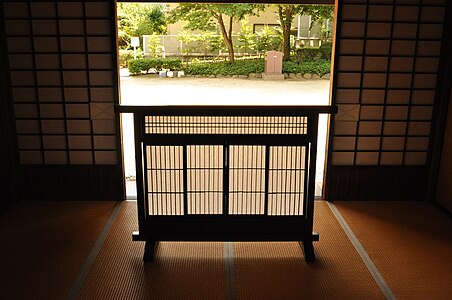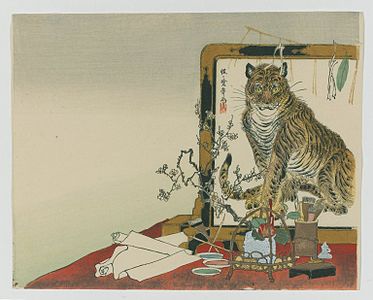Tsuitate
A tsuitate (衝立) is a form of single-panel portable partition traditionally used in Japan since at least the 6th century.[1] They may be made of wood, or a wood frame covered in paper or silk cloth.[1][2] The panels are often illustrated, with paintings on both sides, sometimes by well-known artists.[1] The wood frame may be lacquered,[1][3] and pricier tsuitate may be very richly decorated, including use of precious metals.[3]
Apart from their use as works of art, they are often used to screen entrances, and block wind and sun[2] They may also partition rooms, divide the public part of a shop from the residential area behind, and act as a signboard.[1]
A robust all-wood tsuitate, screening a fire from drafts in a rural house (history exhibit)

A tall 1700s tsuitate, presumably a replica konmeichi screen.[4]

Tsuitate could be made in one piece, or as here, with a separate stand and panel[5]

Tsuitate are traditionally used to screen entrances[6]

A print of a painting by Kawanabe Kyōsai, depicitng a tsuitate screen painted by Kyōsai, complete with his signature on the screen[7]
| Wikimedia Commons has media related to Tsuitate (standing screen). |
References[]
- ^ a b c d e Troy Segal. "Beautiful and Functional Japanese Antiques". The Spruce Crafts.CS1 maint: uses authors parameter (link)
- ^ a b "Tsuitate shouji 衝立障子". Dictionary of Japanese Architectural and Art Historical Terminology.
- ^ a b "A Magnificent Large Gold Lacquer Tsuitate [Standing Screen] , MEIJI PERIOD (LATE 19TH CENTURY)". www.christies.com.
- ^ "Konmeichi-no-shouji 昆明池障子". Dictionary of Japanese Architectural and Art Historical Terminology.
- ^ Morse, Edward S. (1885). "3: Interiors". Japanese Homes and their Surroundings. Charles E. Tuttle Company. ISBN 0-8048-0998-4.
- ^ van der Reyden, Dianne Lee. "THE HISTORY, TECHNOLOGY, AND CARE OF FOLDING SCREENS: CASE STUDIES OF THE CONSERVATION TREATMENT OF WESTERN AND ORIENTAL SCREENS" (PDF). Cite journal requires
|journal=(help) - ^ "Standing Screen (Tsuitate) of a Tiger". www.brooklynmuseum.org. Brooklyn Museum.
- Furnishings
- Japanese traditions
- Japanese woodwork
- Textile arts of Japan
- Japanese words and phrases
- Partitions in traditional Japanese architecture
- Portable furniture





